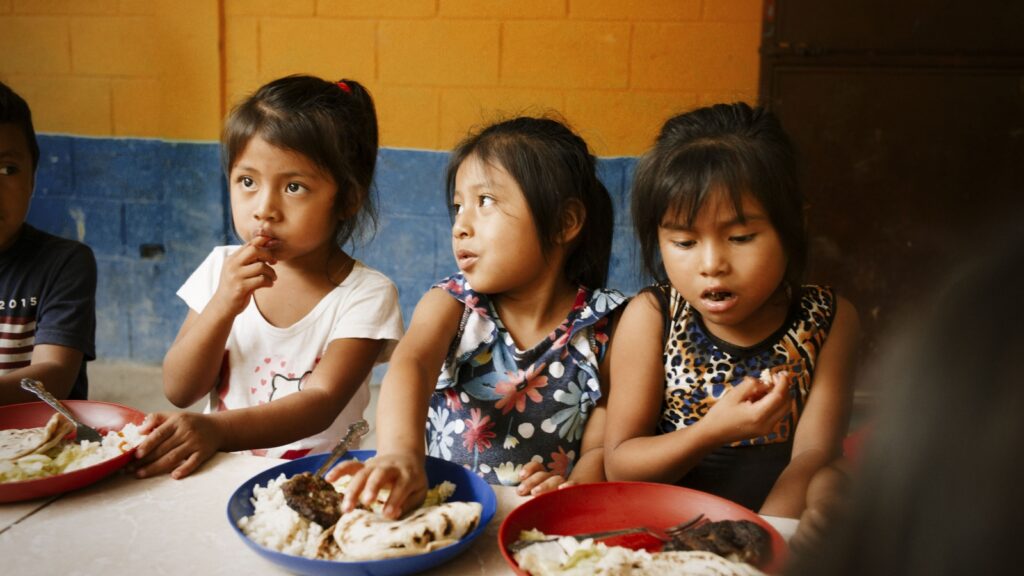Food & Climate
School food may be the best way to teach new generations how to eat a healthy, balanced diet, and even how to produce it. This was demonstrated by the experiences of 3 women from 3 countries: El Salvador, the Dominican Republic, and Guatemala.
A teacher from El Salvador, a young student from the Dominican Republic and a family farmer from Guatemala have never met, but their life stories are wound around the same cause.
They all believe in and work to harness the transformative power of healthy school food, according to a report seen by “Food & Climate” platform.
Instill healthy eating
In the community of Concepción de Ataco, in Ahuachapán, El Salvador, what began as an academic assignment for teacher Esmeralda Ruiz became instead a mission: to instill healthy eating habits in her school community.
In 2020, Esmeralda participated in a course on the Development of Healthy and Sustainable School Environments. This course was taught with the support of the Sustainable School Feeding Network (RAES) and with the technical assistance of the Food and Agriculture Organization of the United Nations (FAO), the government of El Salvador, the Brazilian Cooperation Agency (ABC) and the National Fund for the Development of Education of Brazil within the framework of the Brazil-FAO International Cooperation Program.
She organized healthy eating events and fairs at the school with talks designed specifically for parents. In the garden, children learn about growing food, the importance of a balanced diet and connecting with the environment, while integrating language and math skills into a “green classroom”.
Approaching food and nutrition from multiple dimensions, this school is transforming the eating habits of nearly 600 students and their families.
And in the Dominican Republic, Keyla Jasmil Mariano, 13 years old, is a student at the Mata Limón school in Monte Plata, Dominican Republic.
When she entered school, she had little interest in the subject of nutrition, but this perspective changed as she became involved in growing food, such as tomatoes and lettuce. “We see how food is born; the time it takes to produce it and how to take care of it. I think it is very important for schools to have gardens,” she says enthusiastically.

The Mata Limón school is one of more than 23 000 in the region that have implemented the Sustainable Schools methodology, developed by FAO, the Brazilian Cooperation Agency and the National Fund for the Development of Education of Brazil within the framework of the Brazil-FAO International Cooperation Program. With the support of the Dominican Republic’s National Institute of Student Welfare, the methodology includes school gardens and food and nutrition education.
Through talks and activities led by teachers, Keyla learned about the production of foods and began to eat vegetables, such as cabbage, that she previously rejected. Keyla is one of the 300 students who have learned to value healthy eating thanks to the school garden.
School food programme in Guatemala
Becoming a supplier for the school food programme in Guatemala has allowed a network of family farmers to count on a regular income, strengthening their production and revitalizing the local economy.
Meanwhile, in Guatemala, family farmer Berbely Rodríguez finds a regular market for her products through school feeding programmes, guaranteeing income for her family while delivering fresh food for thousands of students.
In the municipality of Tejutla, department of San Marcos, Guatemala, Berbely is one of 29 farmers who have found a stable source of income by becoming registered with the Ministry of Agriculture, Livestock and Food as part of the Network of Tejutleco family farmer suppliers. This regularity has allowed them to strengthen their production and contribute to the revitalization of the local economy of their community.
Berbely comments, “Now I don’t see it as difficult because we already have a secure market.”
The Network supplies 131 schools in the municipality. Each school has five producers who plant in stages to meet school demand. “They are families who have accepted the challenge and have experienced significant economic change. This network changed our history,” says Berbely.
Berbely, her husband and three children collaborate at all stages, from planting the vegetables and aromatic herbs to weekly delivery to the schools for the 36 weeks of the Guatemalan school year. She currently supplies five schools with 697 students.
The farmers of the Network are supported by a Joint United Nations Programme, financed by the Swedish International Cooperation Agency.

School feeding programmes in Latin America are advancing in the last years with concrete increases in the number of students benefitting (currently around 80.3 million), the number of school days with meal provisions, the number of countries with school feeding laws (now up to six) and stronger connections between school feeding and family farmers.

